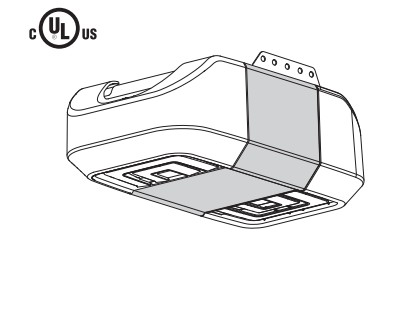This manual is applicable to:
- Belt Drive Models 8355W•8355W-267
- Chain Drive Models 8360W•8360WL•8360WLB•8365W•8365W-267
FOR RESIDENTIAL USE ONLY
- Please read this manual and the safety materials carefully!
- The door WILL NOT CLOSE unless the Protector System® is connected and properly aligned.
- Periodic checks of the garage door opener are required to ensure safe operation.
- This garage door opener is ONLY compatible with myQ® and Security+ 2.0° accessories.
- DO NOT install on a one-piece door if using devices or features providing unattended close. Unattended devices and features are to be used ONLY with sectional doors.
- Attach warning labels to the location indicated on label.
Register your garage door opener to receive updates and offers from LiftMaster
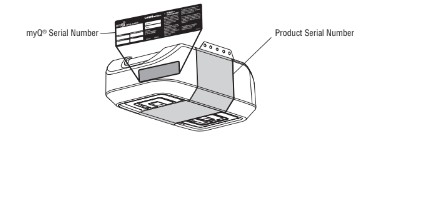
Safety Symbol and Signal Word Review
This garage door opener has been designed and tested to offer safe service provided it is installed, operated, maintained, and tested in strict accordance with the instructions and warnings contained in this manual.
When you see these Safety Symbols and Signal Words on the following pages, they will alert you to the possibility of serious injury or death if you do not comply with the warnings that accompany them. The hazard may come from something mechanical or from electric shock. Read the warnings carefully.
When you see this Signal Word on the following pages, it will alert you to the possibility of damage to your garage door and/or the garage door opener if you do not comply with the cautionary statements that accompany it. Read them carefully.
WARNING: This product can expose you to chemicals including lead, which are known to the State of California to cause cancer or birth defects or other reproductive harm. For more information go to www.P65Warnings.ca.gov
Unattended Operation
The Timer-to-Close (TTC) feature, the myQ Smartphone Control app, and myQ Garage Door and Gate Monitor are examples of unattended close and are to be used ONLY with sectional doors. Any device or feature that allows the door to close without being in the line of sight of the door is considered unattended close. The Timer-to-Close (TTC) feature, the myQ Smartphone Control, and any other myQ devices are to be used ONLY with sectional doors.
Preparation
Test the Wi-Fi signal strength
Before You Begin
You will need:
- Wi-Fi enabled smartphone, tablet or laptop
- Broadband Internet Connection
- Wi-Fi signal in the garage (2.4 Ghz, 802.11b/g/n required)
- Password for your home network (router’s main account, not guest network)
Test the Wi-Fi Signal Strength
Make sure your mobile device is connected to your Wi-Fi network. Hold your mobile device in the place where your garage door opener will be installed and check the Wi-Fi signal strength.
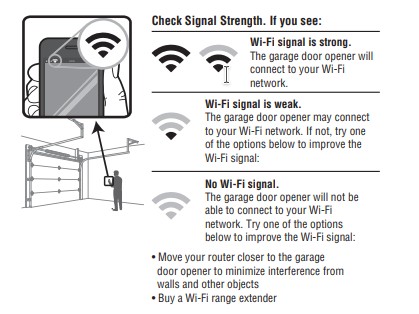
- Signal is Strong: The garage door opener will connect to your Wi-Fi network.
- Wi-Fi signal is weak: The garage door opener may connect to your Wi-Fi network. If not, try one of the options below to improve the Wi-Fi signal
- No Wi-Fi signal: The garage door opener will not be able to connect to your Wi-Fi network. Try one of the options below to improve the Wi-Fi signal
- Move your router closer to the garage door opener to minimize interference from walls and other objects
- Buy a Wi-Fi range extender
See the section on connecting the garage door opener to a smartphone for more info.
Check the Door
WARNING
To prevent possible SERIOUS INJURY or DEATH:
- ALWAYS call a trained door systems technician if garage door binds, sticks, or is out of balance. An unbalanced garage door may NOT reverse when required.
- NEVER try to loosen, move or adjust garage door, door springs, cables, pulleys, brackets or their hardware, ALL of which are under EXTREME tension.
- Disable ALL locks and remove ALL ropes connected to garage door BEFORE installation and operating garage door opener to avoid entanglement.
- DO NOT install on a one-piece door if using devices or features providing unattended close. Unattended devices and features are to be used ONLY with sectional doors.
CAUTION
To prevent damage to garage door and opener.
- ALWAYS disable locks BEFORE installing and operating the opener.
- ONLY operate garage door opener at 120V, 60 Hz to avoid malfunction and damage.
Before you begin:

- Disable locks and remove any ropes connected to the garage door.
- Lift the door halfway up. Release the door. If balanced, it should stay in place, supported entirely by its springs.
- Raise and lower the door to check for binding or sticking. If your door binds, sticks, or is out of balance, call a trained systems technician.
- Check the seal on the bottom of the door. Any gap between the floor and the bottom of the door must not exceed 1/4″ (6 mm).Otherwise, the safety reversal system may not work properly.
- The opener should be installed above the center of the door. If there is a torsion spring or center bearing plate in the way of the header bracket, it may be installed within 4 feet (1.2 m) to the left or right of the door center.
Tools Needed
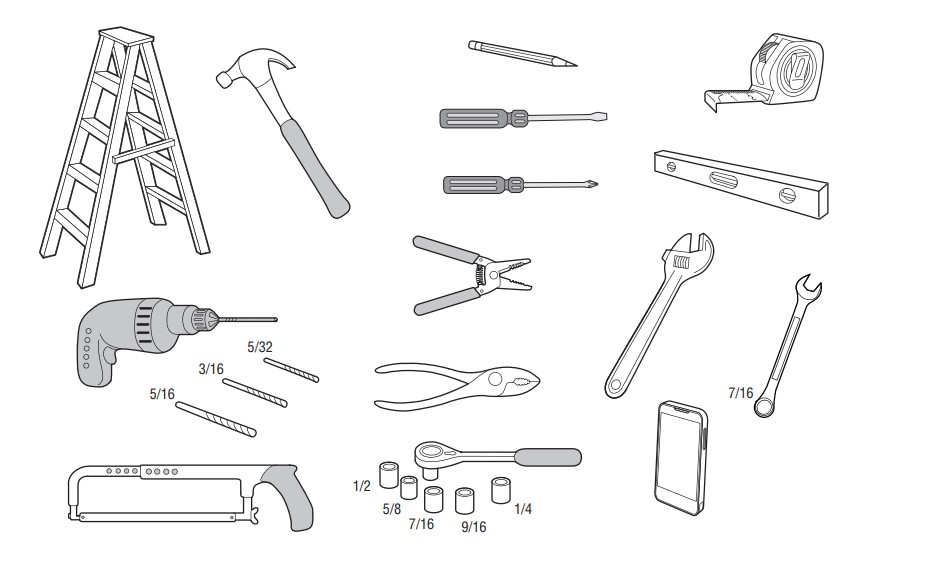
Carton Inventory
Accessories will vary depending on the garage door opener model purchased. Depending on your specific model, other accessories may be included with your garage door opener. The instructions for these accessories will be attached to the accessory and are not included in this manual. The images throughout this manual are for reference and your product may look different.
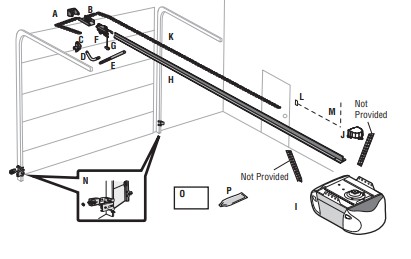
A. Header bracket
B. Pulley and bracket
C. Door bracket
D. Curved door arm
E. Straight door arm
F. Trolley
G. Emergency release rope and handle
H. Rail
I. Garage door opener
J. Sprocket cover with hex screws
K. Belt
L. Door control
M. White and red/white wire
N. The Protector System® Safety reversing sensors with white and white/black wire attached: Sending senor (1), receiving sensor (1), and safety sensor brackets (2)
O. Safety labels and literature
P. Rail grease
Security+ 2.0 Accessories
882LMW

Multi-Function Door Control
893LM

Remote Control
Hardware
Installation
- Hex Bolt 5/16″-18 x 7/8″ (4)
- Lag Screw 5/16″-9 x 1-5/8″ (2)
- Clevis Pin 5/16″ x 2-3/4″ (1)
- Clevis Pin 5/16″ x 1-1/4″ (1)
- Clevis Pin 5/16″ x 1″ (1)
- Nut 5/16″-18 (4)
- Lock Washer 5/16″-16 (4)
- Self-Threading Screw 1/4″-14 x 5/8″ (2)
- Ring Fastener (3)
- Carriage Bolt 1/4°-20 x 1/2″ (2)
- Wing Nut 1/4°-20 (2)
Door Control Hardware
- Screw 6AB x 1° (2)
- Screw 6-32 x 1″ (2)
- Drywall Anchors (2)
Assembly (Assembly for Models 8355W and 8355W-267)
1 Attach the Rail to the Garage Door Opener
WARNING: To avoid possible SERIOUS INJURY to finger from moving garage door opener:
- ALWAYS keep hand clear of sprocket while operating opener.
- Securely attach sprocket cover BEFORE operating.
CAUTION: To avoid SERIOUS damage to garage door opener, use ONLY those bolts/fasteners mounted in the top of the opener.
NOTE: ONLY use the bolts removed from the garage door opener. Place the garage door opener on the packing material to prevent scratching.
- Remove bolt and lock nut from the top of the garage door opener.
- Align the rail and the styrofoam over the sprocket. Cut the tape from the rail, belt, and styrofoam.
- Fasten the rail with the previously removed washered bolt and lock nut.
- Position the belt around the garage door opener sprocket.
- Attach the sprocket cover over the garage door opener sprocket and attach with hex screws.
HARDWARE
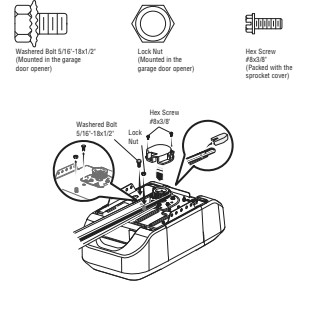
2 Tighten the Belt
- By hand, thread the spring trolley nut on the threaded shaft until it is finger tight against the trolley. Do not use any tools.
- Insert a flathead screwdriver tip into one of the nut ring slots and brace it firmly against the trolley.
- Tighten the spring trolley nut with an adjustable wrench or a 7/16″ open end wrench about a quarter tum until the spring releases and snaps the nut ring against the trolley. This sets the spring to optimum belt tension.
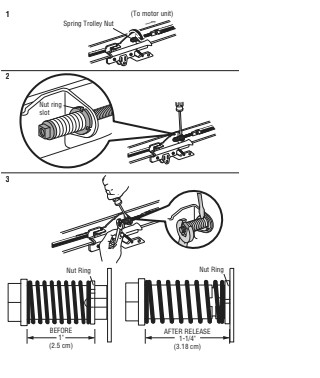
Assembly (Models 8360W, 8360WL, 8360WLB, 8365W, and 8365W-267)
1 Attach the Rail to the Garage Door Opener
WARNING: To avoid possible SERIOUS INJURY to finger from moving garage door opener:
- ALWAYS keep hand clear of sprocket while operating opener.
- Securely attach sprocket cover BEFORE operating.
CAUTION: To avoid SERIOUS damage to garage door opener, use ONLY those bolts/fasteners mounted in the top of the opener.
NOTE: ONLY use the bolts removed from the garage door opener. Place the garage door opener on the packing material to prevent scratching.
- Remove the two bolts from the top of the garage door opener.
- Align the rail and the styrofoam over the sprocket. Cut the tape from the rail, chain, and styrofoam.
- Fasten the rail with the previously removed bolts.
- 4. Position the chain around the garage door opener sprocket.
- 5. Install the sprocket cover by squeezing the sides and inserting the tabs into the slots on the garage door opener.
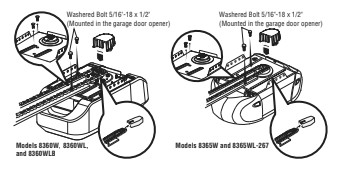
2 Tighten the Chain
- Loosen the inner nut and lock washer on the trolley threaded shaft.
- Tighten the outer nut until the chain is a 1/2″ above the base of the rail at the midpoint of the rail.
- Re-tighten the inner nut.
Slack in the chain is normal when the door is closed. No readjustment is necessary.

To reduce the risk of SEVERE INJURY or DEATH:
READ AND FOLLOW ALL INSTALLATION WARNINGS AND INSTRUCTIONS.
- Install garage door opener ONLY on properly balanced and lubricated garage e within sight of the garage door. An improperly balanced door may NOT reverse when required and could result in SEVERE INJURY or DEATH.
- ALL repairs to cables, spring assemblies and other hardware MUST be made by a trained door systems technician BEFORE installing opener.
- Disable ALL locks and remove ALL ropes connected to garage door BEFORE installing opener to avoid entanglement.
- Where possible, install the door opener 7 feet (2.13 m) or more above the floor.
- Mount the emergency release within reach, but at least 6 feet (1.83 m) above the floor and avoiding contact with vehicles to avoid accidental release.
- NEVER connect garage door opener to power source until instructed to do so.
- NEVER wear watches, rings or loose clothing while installing or servicing opener. They could be caught in garage door or opener mechanisms.
- Install wall-mounted garage door control:
- Within sight of the garage door.
- Out of reach of small children at a minimum height of 5 feet (1.5 m) above floors, landings, steps or any other adjacent walking surface.
- away from ALL moving parts of the door.
- Place entrapment warning label on the wall next to garage door control in a prominent location.
- Place emergency release/safety reverse test label in plain view on inside of garage door.
- Upon completion of installation, test safety reversal system. Door MUST reverse on contact with a 1-1/2″ (8.8 cm) high object (or a 2×4 laid flat) on the floor.
- DO NOT install on a one-piece door if using devices or features providing unattended close. Unattended devices and features are to be used ONLY with sectional doors.
Installation
1 Determine the Header Bracket Location
WARNING
To prevent possible SERIOUS INJURY or DEATH:
- Header bracket MUST be RIGIDLY fastened to structural support on header wall or ceiling, otherwise garage door might NOT reverse when required. DO NOT install header bracket over drywall.
- Concrete anchors MUST be used if mounting header bracket or 2×4 into masonry.
- NEVER try to loosen, move or adjust garage door, springs, cables, pulleys, brackets, or their hardware, ALL of which are under EXTREME tension.
- ALWAYS call a trained door systems technician if garage door binds, sticks, or is out of balance. An unbalanced garage door might NOT reverse when required.
- DO NOT enable the Timer-to-Close functionality if operating either one-piece or swinging garage doors. To be enabled ONLY when operating a sectional door.
Close the door and mark the inside vertical centerline of the garage door. Extend the line onto the header wall above the door. You can fasten the header bracket within 4 feet (1.22 m) of the left or right of the door center only if a torsion spring or center bearing plate is in the way; or you can attach it to the ceiling when clearance is minimal. (It may be mounted on the wall upside down if necessary, to gain approximately 1/2″ (1 cm). If you need to install the header bracket on a 2×4 (on wall or ceiling), use lag screws (not provided) to securely fasten the 2×4 to structural supports.
Open your door to the highest point of travel as shown. Draw an intersecting horizontal line on the header wall 2″ (6 cm) above the high point. This height will provide travel clearance for the top edge of the door.
NOTE: If the total number of inches exceeds the height available in your garage, use the maximum height possible, or refer to page 14 for ceiling installation.
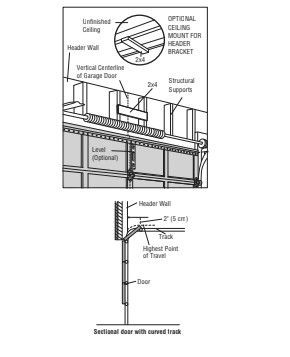
2. Install the Header Bracket
You can attach the header bracket either to the wall above the garage door, or to the ceiling. Follow the instructions which will work best for your particular requirements. Do not install the header bracket over drywall. If installing into masonry, use concrete anchors (not provided)

OPTION A – WALL INSTALLATION
- Center the bracket on the vertical centerline with the bottom edge of the bracket on the horizontal line as shown (with the arrow pointing toward the ceiling).
- Mark the vertical set of bracket holes (do not use the holes designated for ceiling mount). Drill 3/16″ pilot holes and fasten the bracket securely to a structural support with lag screws.
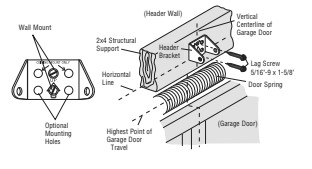
OPTION B – CEILING INSTALLATION
- Extend the vertical centerline onto the ceiling as shown.
- Center the bracket on the vertical mark, no more than 6″ (15 cm) from the wall. Make sure the arrow is pointing toward the wall. The bracket can be mounted flush against the ceiling when clearance is minimal.
- Mark the side holes. Drill 3/16″ pilot holes and fasten bracket securely to a structural support with the hardware provided.
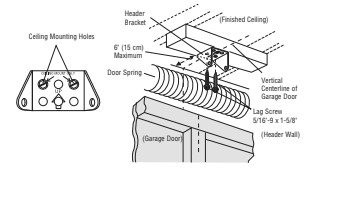
3. Attach the Rail to the Header Bracket
- Align the rail with the header bracket. Insert the clevis pin through the holes in the header bracket and rail. Secure with the ring fastener.
NOTE: Use the packing material as a protective base for the garage door opener.
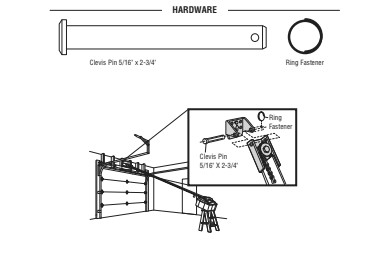
4. Position the Garage Door Opener
CAUTION To prevent damage to garage door, rest garage door opener rail on 2×4 placed on top section of door.
- Remove the packing material and lift the garage door opener onto a ladder.
- Fully open the door and place a 2×4 (laid flat) under the rail.
A 2×4 is ideal for setting the distance between the rail and the door. If the ladder is not tall enough you will need help at this point. If the door hits the trolley when it is raised, pull the trolley release arm down to disconnect the inner and outer trolley. Slide the outer trolley toward the garage door opener. The trolley can remain disconnected until instructed.
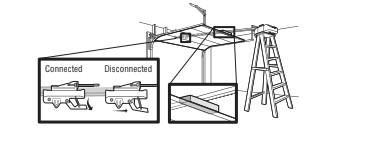
5. Hang the Garage Door Opener
To avoid possible SERIOUS INJURY from a falling garage door opener, fasten it SECURELY to structural supports of the garage. Concrete anchors MUST be used if installing ANY brackets into masonry.
Hanging your garage door opener will vary depending on your garage. Two representative installations are shown. Yours may be different. Hanging brackets should be angled (Figure 1) to provide rigid support. On finished ceilings (Figure 2), attach a sturdy metal bracket to structural supports before installing the opener. This bracket and fastening hardware are not provided.
- Measure the distance from each side of the motor unit to the structural support.
- Cut both pieces of the hanging bracket to required lengths.
- Drill 3/16″ pilot holes in the structural supports.
- Attach one end of each bracket to a support with 5/16″-18 x 1-7/8″ lag screws (not provided).
- Fasten the opener to the hanging brackets with 5/16″-18 x 7/8″ hex bolts, lock washers and nuts.
- Check to make sure the rail is centered over the door (or in line with the header bracket if the bracket is not centered above the door).
- Remove the 2×4. Operate the door manually. If the door hits the rail, raise the header bracket.
NOTE: DO NOT connect power to opener at this time.
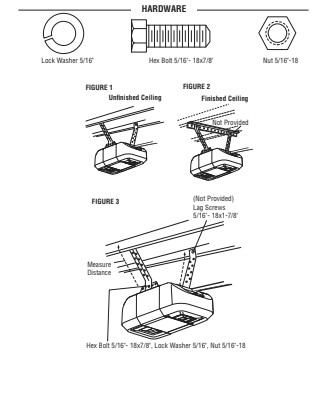
6. Install the Light Bulbs
Models 8355W, 8355-267, 8360W, 8360WL, and 8360WLB
CAUTION
To prevent possible OVERHEATING of the end panel or light socket:
- Use ONLY A19 incandescent (100W maximum) or compact fluorescent (26W maximum) light bulbs.
- DO NOT use incandescent bulbs larger than 100W.
- DO NOT use compact fluorescent light bulbs larger than 26W (100W equivalent).
- DO NOT use halogen bulbs.
- DO NOT use short neck or specialty light bulbs.
- Pull on the top center of the light lens and rotate the light lens down.
- Insert an A19 incandescent (100W maximum) or compact fluorescent (26W, 100W equivalent) light bulb into the light socket.
NOTE: DO NOT use halogen, short neck, or specialty light bulbs as these may overheat the end panel or light socket. DO NOT use LED bulbs as they may reduce the range or performance of your remote control(s).
3. Rotate the lens up to close.
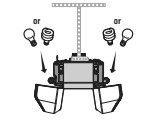
Models 8365W and 8365-267
CAUTION
To prevent possible OVERHEATING of the end panel or light socket:
- DO NOT use short neck or specialty light bulbs.
- DO NOT use halogen bulbs. Use ONLY incandescent.
To prevent damage to the opener:
- DO NOT use bulbs larger than 100W.
- ONLY use A19 size bulbs.
- Press the release tabs on both sides of lens. Gently rotate lens back and downward until the lens hinge is in the fully open position. Do not remove the lens.
- Install a 100 watt maximum light bulb in each socket. Light bulb size should be A19, standard neck only. The lights will turn ON and remain lit for approximately 4-1/2 minutes when power is connected. Then the lights will turn OFF.
- Reverse the procedure to close the lens.
NOTE: If the bulbs burn out prematurely due to vibration, replace with A19, standard neck garage door opener bulbs. The use of short neck or specialty light bulbs may overheat the end panel or light socket.
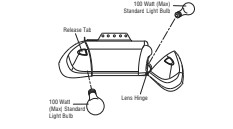
7. Attach the Emergency Release Rope and Handle
WARNING
To prevent possible SERIOUS INJURY or DEATH from a falling garage door:
- If possible, use emergency release handle to disengage trolley ONLY when garage door is CLOSED. Weak or broken springs or unbalanced door could result in an open door falling rapidly and/or unexpectedly.
- NEVER use emergency release handle unless garage doorway is clear of persons and obstructions.
- NEVER use handle to pull door open or closed. If rope knot becomes untied, you could fall.
- Insert one end of the emergency release rope through the handle. Make sure that “NOTICE” is right side up. Secure with an overhand knot at least 1° (2.5 cm) from the end of the rope to prevent slipping.
- Insert the other end of the emergency release rope through the hole in the trolley release arm. Mount the emergency release within reach, but at least 6 feet (1.83 m) above floor, avoiding contact with vehicles to prevent accidental release and secure with an overhand knot.
NOTE: If it is necessary to cut the emergency release rope, seal the cut end with a match or lighter to prevent unraveling. Ensure the emergency release rope and handle are above the top of all vehicles to avoid entanglement.
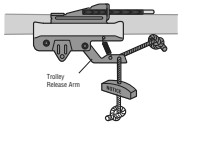
8. Install the Door Bracket
CAUTION
Fiberglass, aluminum or lightweight steel garage doors WILL REQUIRE reinforcement BEFORE installation of door bracket. Contact the garage door manufacturer or installing dealer for opener reinforcement instructions or reinforcement kit. Failure to reinforce the top section as required according to the door manufacturer may void the door warranty. A horizontal and vertical reinforcement is needed for lightweight garage doors (fiberglass, aluminum, steel, doors with glass panel, etc.) (not provided). A horizontal reinforcement brace should be long enough to be secured to two or three vertical supports. A vertical reinforcement brace should cover the height of the top panel. Contact the garage door manufacturer or installing dealer for opener reinforcement instructions or reinforcement kit.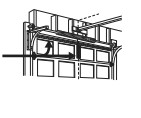
NOTE: Many door reinforcement kits provide for direct attachment of the clevis pin and door arm. In this case you will not need the door bracket; proceed to the next step.
SECTIONAL DOORS
- Center the door bracket on the previously marked vertical centerline used for the header bracket installation. Note correct UP placement, as stamped inside the bracket.
- Position the top edge of the bracket 2′-4″ (5-10 cm) below the top edge of the door, OR directly below any structural support across the top of the door.
- Mark, drill holes and install as follows, depending on your door’s construction:
Metal or light weight doors using a vertical angle iron brace between the door panel support and the door bracket:
- Drill 3/16″ fastening holes. Secure the door bracket using the two self threading screws. (Figure 1)
- Alternately, use two 5/16°-18×2″ bolts, lock washers and nuts (not provided). (Figure 2)
Metal, insulated or light weight factory reinforced doors:
- Drill 3/16″ fastening holes. Secure the door bracket using the self-threading screws. (Figure 3)
Wood Doors:
- Use top and bottom or side to side door bracket holes. Drill 5/16” holes through the door and secure bracket with 5/16″-18 x 2″ carriage bolts, lock washers and nuts (not provided). (Figure 4)
NOTE: The 1/4′-14 x 5/8″ self-threading screws are not intended for use on wood doors.
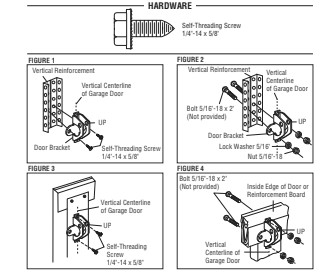
Connect the Door Arm to the Trolley
IMPORTANT: The groove on the straight door arm MUST face away from the curved door arm.
- Close the door. Disconnect the trolley by pulling the emergency release handle. Slide the outer trolley back (away from the door) about 2″ (5 cm).
- Attach the curved door arm to the door bracket using the clevis pin. Attach with the ring fastener.
- Attach the straight door arm to the outer trolley using the clevis pin. Attach with the ring fastener.
- Align the straight door arm with the curved door arm. Select two aligned holes (as far apart as possible) and attach using the bolts, nuts and lock washers.
NOTE: If the holes do not line up, reverse the straight door arm. Select two aligned holes (as far apart as possible) and attach using the bolts, nuts and lock washers.
- Pull the emergency release handle toward the garage door opener until the trolley release arm is horizontal. The trolley will re-engage automatically when the garage door opener is activated.
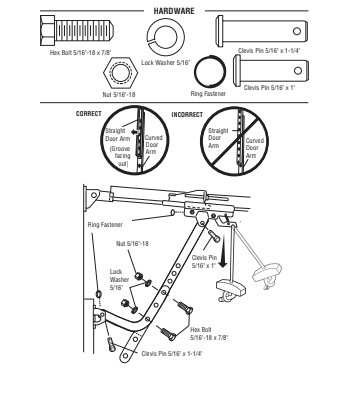
Install the Door Control
1. Install the Door Control
WARNING
To prevent possible SERIOUS INJURY or DEATH from electrocution:
- Be sure power is NOT connected BEFORE installing door control.
- Connect door control ONLY to 12 VOLT low voltage wires.
To prevent possible SERIOUS INJURY or DEATH from a closing garage door:
- Install door control within sight of garage door, out of reach of small children at a minimum height of 5 feet (1.5 m) above floors, landings, steps or any other adjacent walking surface, and away from ALL moving parts of door.
- NEVER permit children to operate or play with door control push buttons or remote control transmitters.
- Activate door ONLY when it can be seen clearly, is properly adjusted, and there are no obstructions to door travel.
- ALWAYS keep garage door in sight until completely closed. NEVER permit anyone to cross path of closing garage door.
INTRODUCTION
Compatible with myQ and Security+ 2.0© accessories, see page 46. Your garage door opener is compatible with up to 2 Smart Control Panels or 4 of any other Security+ 2.0© door controls. NOTE: Older LiftMaster door controls and third party products are not compatible.
Install door control within sight of garage door, out of reach of small children at a minimum height of 5 feet (1.5 m) above floors, landings, steps or any other adjacent walking surface, and away from ALL moving parts of door. For gang box installations it is not necessary to drill holes or install the drywall anchors. Use the existing holes in the gang box.
NOTE: Your product may look different than the illustrations.

- Strip 7/16″ (11 mm) of insulation from one end of the wire and separate the wires.
- Connect one wire to each of the two screws on the back of the door control. The wires can be connected to either screw.
PRE-WIRED INSTALLATIONS: Choose any two wires to connect, note which wires are used so the correct wires are connected at the garage door opener in a later step.
- Mark the location of the bottom mounting hole and drill a 5/32″ hole.
- Install the bottom screw, allowing 1/8″ (3 mm) to protrude from the wall.
- Position the bottom hole of the door control over the screw and slide down into place.
- Lift the push bar up and mark the top hole.
- Remove the door control from the wall and drill a 5/32″ hole for the top screw.
- Position the bottom hole of the door control over the screw and slide down into place. Attach the top screw.
2.Wire the door control to the garage door opener
PRE-WIRED INSTALLATIONS: When wiring the door control to the garage door opener inside of the garage door make sure you use the same wires that are connected to the door control.
- Run the white and red/white wire from the door control to the garage door opener. Attach the wire to the wall and ceiling with staples (not applicable for gang box or pre-wired installations). Do not pierce the wire with the staple as this may cause a short or an open circuit.
- Strip 7/16″ (11 mm) of insulation from the end of the wire near the garage door opener.
- Connect the wire to the red and white terminals on the garage door opener. To insert or release wires from the terminal, push in the tab with screwdriver tip.
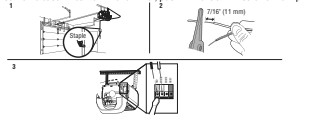
3. Attach the warning labels
- Attach the entrapment warning label on the wall near the door control with tacks or staples.
- Attach the manual release/safety reverse test label in a visible location on the inside of the garage door.
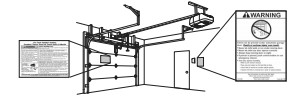
Install the Protector System®
WARNING
Be sure power is NOT connected to the garage door opener BEFORE installing the safety reversing sensor.
To prevent SERIOUS INJURY or DEATH from closing garage door:
- Correctly connect and align the safety reversing sensor. This required safety device MUST NOT be disabled.
- Install the safety reversing sensor so beam is NO HIGHER than 6″ (15 cm) above garage floor.
IMPORTANT INFORMATION ABOUT THE SAFETY REVERSING SENSORS
The safety reversing sensors must be connected and aligned correctly before the garage door opener will move in the down direction.
The sending sensor (with an amber LED) transmits an invisible light beam to the
receiving sensor (with a green LED). If an obstruction breaks the light beam while the door is closing, the door will stop and reverse to the full open position, and the garage door opener lights will flash 10 times.
NOTE: For energy efficiency the garage door opener will enter sleep mode when the door is fully closed. The sleep mode shuts the garage door opener down until activated. The sleep mode is sequenced with the garage door opener lights; as the lights turns off, the sensor LEDs will turn off and whenever the garage door opener lights turn on, the sensor LEDs will light. The garage door opener will not go into the sleep mode until the garage
door opener has completed 5 cycles upon power up.
When installing the safety reversing sensors check the following:
- Sensors are installed inside the garage, one on either side of the door.
- Sensors are facing each other with the lenses aligned and the receiving sensor lens does not receive direct sunlight.
- Sensors are no more than 6 inches (15 cm) above the floor and the light beam is unobstructed.
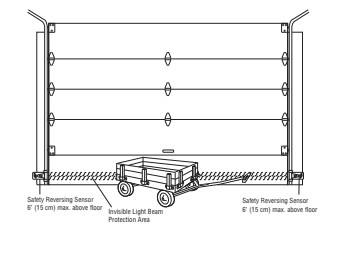
1 Install the Safety Reversing Sensors
The safety reversing sensors can be attached to the door track, the wall, or the floor. If the door track will not support the sensor bracket a wall installation is recommended. Choose one of the following installations.

OPTION A – DOOR TRACK INSTALLATION
- Slide the curved arms of the sensor bracket around the edge of the door track.
- Snap into place so that the sensor bracket is flush against the track.
- Slide the carriage bolt into the slot on each sensor.
- Insert the bolt through the hole in the sensor bracket and attach with the wing nut. The lenses on both sensors should point toward each other. Make sure the lens is not obstructed by the sensor bracket.

OPTION B – WALL INSTALLATION
If additional clearance is needed an extension bracket (not provided) or wood blocks can be used. Make sure each bracket hs the same amount of clearance so they will align correctly.
- Position the sensor bracket against the wall with the curved arms facing the door. Make sure there is enough clearance for the beam to be unobstructed. Mark holes.
- Drill 3/16 inch pilot holes for each sensor bracket and attach the sensor brackets to the wall using lag screws (not provided).
- Slide the carriage bolt into the slot on each sensor.
- Insert the bolt through the hole in the sensor bracket and attach with the wing nut. The lenses on both sensors should point toward each other. Make sure the lens is not obstructed by the sensor bracket.
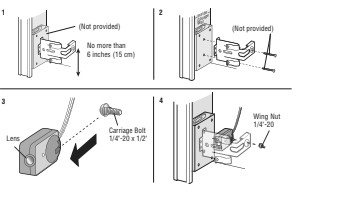
OPTION C – FLOOR INSTALLATION
Use an extension bracket (not provided) or wood block to raise the sensor bracket if needed.
- Carefully measure the position of both sensor brackets so they will be the same distance from the wall and unobstructed.
- Attach the sensor brackets to the floor using concrete anchors (not provided).
- Slide the carriage bolt into the slot on each sensor.
- Insert the bolt through the hole in the sensor bracket and attach with the wing nut. The lenses on both sensors should point toward each other. Make sure the lens is not obstructed by the sensor bracket.
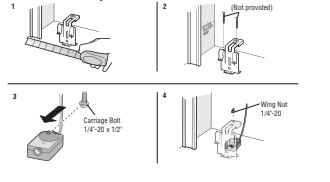
2 Wire the Safety Reversing Sensors
PRE-WIRED INSTALLATIONS: If your garage already has wires installed for the safety reversing sensors, see page 26
OPTION A – INSTALLATION WITHOUT PRE-WIRING
- Run the wire from both sensors to the garage door opener. Attach the wire to the wall and ceiling with staples.
- Strip 7/16 inch (11 mm) of insulation from each set of wires. Separate the wires. Twist the white wires together. Twist the white/black wires together.
- Insert the white wires into the white terminal on the garage door opener. Insert the white/black wires into the grey terminal on the garage door opener. To insert or remove the wires from the terminal, push in the tab with a screwdriver tip.
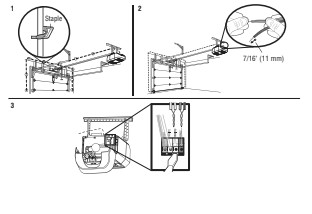
OPTION B – PRE-WIRED INSTALLATION
- Cut the end of the safety reversing sensor wire, making sure there is enough wire to reach the pre-installed wires from the wall.
- Separate the safety reversing sensor wires and strip 7/16 inch (11 mm) of insulation from each end. Choose two of the pre-installed wires and strip 7/16 inch (11 mm) of insulation from each end. Make sure that you choose the same color pre-installed wires for each sensor.
- Connect the pre-installed wires to the sensor wires with wire nuts making sure the colors correspond for each sensor. For example, the white wire would connect to the yellow wire and the white/black wire would connect to the purple wire.
- At the garage door opener, strip 7/16 inch (11 mm) of insulation from each end of the wires previously chosen for the safety reversing sensors. Twist the like-colored wires together.
- Insert the wires connected to the white safety sensor wires to the white terminal on the garage door opener. Insert the wires that are connected to the white/black safety sensor wires to the grey terminal on the garage door opener.
Power
1 Connect Power
WARNING
To prevent possible SERIOUS INJURY or DEATH from electrocution or fire:
- Be sure power is NOT connected to the opener, and disconnect power to circuit BEFORE removing cover to establish permanent wiring connection.
- Garage door installation and wiring MUST be in compliance with ALL local electrical and building codes.
- NEVER use an extension cord, 2-wire adapter, or change plug in ANY way to make it fit outlet. Be sure the opener is grounded.
To avoid installation difficulties, do not activate the garage door opener at this time.
To reduce the risk of electric shock, your garage door opener has a grounding type plug with a third grounding pin. This plug will only fit into a grounding type outlet. If the plug doesn’t fit into your outlet, contact a qualified electrician to install the proper outlet.

THERE ARE TWO OPTIONS FOR CONNECTING POWER:
OPTION A – TYPICAL WIRING
- Plug in the garage door opener into a grounded outlet.
- DO NOT run garage door opener at this time.

OPTION B – PERMANENT WIRING
If permanent wiring is required by your local code, refer to the following procedure. To make a permanent connection through the 7/8 inch hole in the top of the motor unit (according to local code):
- Remove the motor unit cover screws and set the cover aside.
- Remove the attached 3-prong cord.
- Connect the black (line) wire to the screw on the brass terminal; the white (neutral) wire to the screw on the silver terminal; and the ground wire to the green ground screw. The opener must be grounded.
- Reinstall the cover.
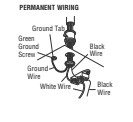
2 Ensure the Safety Reversing Sensors are Aligned
The door will not close if the sensors have not been installed and aligned correctly.
When the light beam is obstructed or misaligned while the door is closing, the door will reverse and the garage door opener lights will flash ten times. If the door is already open, it will not close. The sensors can be aligned by loosening the wing nuts, aligning the sensors, and tightening the wing nuts.
- Check to make sure the LEDs in both sensors are glowing steadily. The LEDs in both sensors will glow steadily if they are aligned and wired correctly.
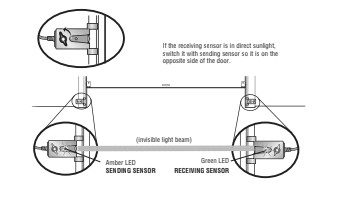
IF THE AMBER LED ON THE SENDING SENSOR IS NOT GLOWING:
- Make sure there is power to the garage door opener.
- Make sure the sensor wire is not shorted/broken.
- Make sure the sensor has been wired correctly: white wires to white terminal and white/black wires to gray terminal.

IF THE GREEN LED ON THE RECEIVING SENSOR IS NOT GLOWING:
- Make sure the sensor wire is not shorted/broken.
- Make sure the sensors are aligned.

3 Ensure the Door Control is Wired Correctly
If the door control has been installed and wired correctly, the command LED behind the push bar will blink.
Adjustments
WARNING
Without a properly installed safety reversal system, persons (particularly small children) could be SERIOUSLY INJURED or KILLED by a closing garage door.
- Incorrect adjustment of garage door travel limits will interfere with proper operation of safety reversal system.
- After ANY adjustments are made, the safety reversal system MUST be tested. Door MUST reverse on contact with 1-1/2″ (3.8 cm) high object (or 2×4 laid flat) on floor.
CAUTION
To prevent damage to vehicles, be sure fully open door provides adequate clearance.
Your garage door opener is designed with electronic controls to make setup and adjustments easy. The adjustments allow you to program where the door will stop in the open (UP) and close (DOWN) position. The electronic controls sense the amount of force required to open and close the door. The force is adjusted automatically when you program the travel.
NOTE: If anything interferes with the doors upward travel it will stop. If anything interferes with the door’s downward travel, it will reverse.
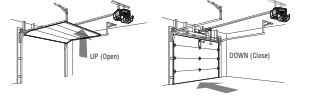
PROGRAMMING BUTTONS
The programming buttons are located on the left side panel of the garage door opened and are used to program the travel. While programming, the UP and DOWN buttons can be used to move the door as needed.
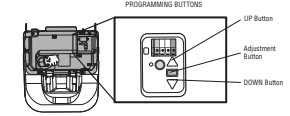
To watch a video, go to youtu.be/Fyl1-SxOxnE
1 Program the Travel
WARNING
Without a properly installed safety reversal system, persons (particularly small children) could be SERIOUSLY INJURED or KILLED by a closing garage door.
- Incorrect adjustment of garage door travel limits will interfere with proper operation of safety reversal system.
- After ANY adjustments are made, the safety reversal system MUST be tested. Door MUST reverse on contact with 1-1/2″ (3.8 cm) high object (or 2×4 laid flat) on floor.
While programming, the UP and DOWN buttons can be used to move the door as needed.
- Press and hold the Adjustment Button until the UP Button begins to flash and/or a beep is heard.
- Press and hold the UP Button until the door is in the desired UP position.
- Once the door is in the desired UP position press and release the Adjustment Button. The garage door opener lights will flash twice and the DOWN Button will begin to flash.
- Press and hold the DOWN button until the door is in the desired DOWN position.
- Once the door is in the desired DOWN position press and release the Adjustment Button. The garage door opener lights will flash twice and the UP Button will begin to flash.
- Press and release the UP Button. When the door travels to the programmed UP position, the DOWN Button will begin to flash.
- Press and release the DOWN Button. The door will travel to the programmed DOWN position. Programming is complete.
If the garage door opener lights are flashing 5 times during the steps for Program the Travel, the programming has timed out. If the garage door opener lights are flashing 10 times during the steps for Program the Travel, the safety reversing sensors are misaligned or obstructed (refer to page 28). When the sensors are aligned and unobstructed, cycle the door through a complete up and down cycle using the remote control or the UP and DOWN buttons. Programming is complete. If you are unable to operate the door up and down, repeat the steps for Programming the Travel.
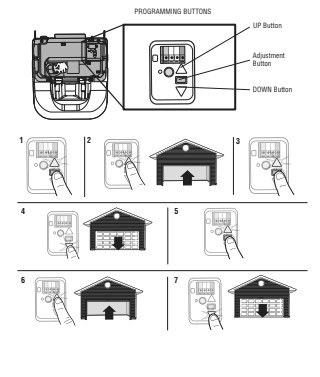
2 Test the Safety Reversal System
WARNING
Without a properly installed safety reversal system, persons (particularly small children) could be SERIOUSLY INJURED or KILLED by a closing garage door.
- Safety reversal system MUST be tested every month.
- After ANY adjustments are made, the safety reversal system MUST be tested. Door MUST reverse on contact with 1-1/2″ (3.8 cm) high object (or 2×4 laid flat) on the floor.
- With the door fully open, place a 1-1/2″ (3.8 cm) board (or a 2×4 laid flat) on the floor, centered under the garage door.
- Press the remote control push button to close the door. The door MUST reverse when it makes contact with the board.
If the door stops but does not reverse:
- Review the installation instructions provided to insure all steps were followed;
- Repeat Program the Travel (see Adjustment Step 1);
- Repeat the Safety Reversal test.
If the test continues to fail, call a trained door systems technician.
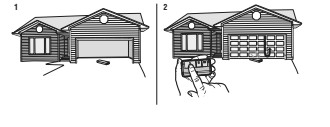
3 Test the Protector System®
WARNING
Without a properly installed safety reversing sensor, persons (particularly small children) could be SERIOUSLY INJURED or KILLED by a closing garage door.
- Open the door. Place the garage door opener carton in the path of the door.
- Press the remote control push button to close the door. The door will not move more than 1″ (2.5 cm), and the garage door opener lights will flash 10 times.
The garage door opener will not close from a remote control if the LED in either safety reversing sensor is off (alerting you to the fact that the sensor is misaligned or obstructed). If the garage door opener closes the door when the safety reversing sensor is obstructed (and the sensors are no more than 6″[15 cm] above the floor), call for a trained door systems technician.
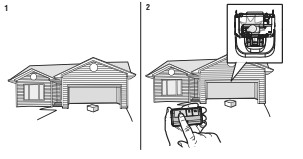
Battery Backup
1 Install the Battery*
WARNING
To reduce the risk of FIRE or INJURY to persons:
- Disconnect ALL electric and battery power BEFORE performing ANY service or maintenance.
- Use ONLY LiftMaster part # 485LM for replacement battery.
- DO NOT dispose of battery in fire. Battery may explode. Check with local codes for disposal instructions.
CAUTION
ALWAYS wear protective gloves and eye protection when changing the battery or working around the battery compartment.
- Unplug the garage door opener.
- Open the light lens on the right side panel of the garage door opener. Use a Phillips head screwdriver to remove the battery cover on the garage door opener.
- Partially insert the battery into the battery compartment with the terminals facing out.
- Connect red (+) and black (-) wires from the garage door opener to the corresponding terminals on the battery.
- Replace the battery cover.
- Plug in the garage door opener.
- Wait for the green Battery Status LED to start flashing before proceeding to test the battery.

2 Test the Battery
- Unplug the garage door opener. The battery status LED will either glow solid orange indicating opener is operating on battery power or will flash indicating low battery power. NOTE: Make sure the garage door opener is unplugged.
- Open and close the door using the remote control or door control. NOTE: The garage door opener may run slower if the battery is not fully charged. The battery will take 24 hours to fully charge.
- Plug in the garage door opener. Verify the battery status LED is flashing green, indicating the battery is charging.

Charge the Battery*
The battery charges when the garage door opener is plugged into a 120Vac electrical outlet that has power and requires 24 hours to fully charge. A fully charged battery supplies 12Vdc to the garage door opener for one to two days of normal operation during an electrical power outage. After the electrical power has been restored, the battery will recharge within 24 hours. The battery will last approximately 1 to 2 years with normal usage. Instructions for replacement are provided with the battery. To obtain maximum battery life and prevent damage, disconnect the battery when the garage door opener is unplugged for an extended period of time, such as a summer or winter home.
NOTE: When the garage door opener is in battery backup mode the garage door opener lights, Timer-to-Close, and Remote Close features are unavailable. In battery backup mode, the Automatic Garage Door Lock will unlock when the garage door is opened, and will remain disabled until power is restored.
* If applicable
Battery Status LED
GREEN LED:
All systems are normal.
- A solid green LED light indicates the battery is fully charged.
- A flashing green LED indicates the battery is being charged.
ORANGE LED:
The garage door opener has lost power and is in battery backup mode.
- A solid orange LED with beep, sounding approximately every 2 seconds, indicates the garage door opener is operating on battery power.
- A flashing orange LED with beep, sounding every 30 seconds, indicates the battery is low.
RED LED:
The garage door opener’s 12V battery needs to be replaced.
- A solid red LED with beep, sounding every 30 seconds, indicates the 12V battery will no longer hold a charge and needs to be replaced. Replace the battery back up to maintain the battery backup feature.
NOTE: The Battery Status LED is most visible with the garage door opener light off. Battery does not have to be fully charged to operate the garage door opener.

IMPORTANT SAFETY INSTRUCTIONS
WARNING
To reduce the risk of SEVERE INJURY or DEATH:
- READ AND FOLLOW ALL WARNINGS AND INSTRUCTIONS.
- ALWAYS keep remote controls out of reach of children. NEVER permit children to operate or play with garage door control push buttons or remote controls.
- ONLY activate garage door when it can be seen clearly, it is properly adjusted, and there are no obstructions to door travel.
- ALWAYS keep garage door in sight and away from people and objects until completely closed. NO ONE SHOULD CROSS THE PATH OF THE MOVING DOOR.
- NO ONE SHOULD GO UNDER A STOPPED, PARTIALLY OPENED DOOR.
- If possible, use emergency release handle to disengage trolley ONLY when garage door is CLOSED. Use caution when using this release with the door open. Weak or broken springs or unbalanced door could result in an open door falling rapidly and/or unexpectedly and increasing the risk of SEVERE INJURY or DEATH.
- NEVER use emergency release handle unless garage doorway is clear of persons and obstructions.
- NEVER use handle to pull garage door open or closed. If rope knot becomes untied, you could fall.
- After ANY adjustments are made, the safety reversal system MUST be tested.
- Safety reversal system MUST be tested every month. Garage door MUST reverse on contact with 1-1/2″ (3.8 cm) high object (or a 2×4 laid flat) on the floor. Failure to adjust the garage door opener properly increases the risk of SEVERE INJURY or DEATH.
- ALWAYS KEEP GARAGE DOOR PROPERLY BALANCED (see page 4). An improperly balanced door may NOT reverse when required and could result in SEVERE INJURY or DEATH.
- ALL repairs to cables, spring assemblies and other hardware, ALL of which are under EXTREME tension, MUST be made by a trained door systems technician.
- To avoid SERIOUS PERSONAL INJURY or DEATH from electrocution, disconnect ALL electric and battery power BEFORE performing ANY service or maintenance.
- This operator system is equipped with an unattended operation feature. The door could move unexpectedly. NO ONE SHOULD CROSS THE PATH OF THE MOVING DOOR.
- DO NOT install on a one-piece door if using devices or features providing unattended close. Unattended devices and features are to be used ONLY with sectional doors.
- SAVE THESE INSTRUCTIONS.
Features
Your garage door opener is equipped with features to provide you with greater control over your garage door operation.
Alert2Close
The Alert2Close feature provides a visual and an audible alert that an unattended door is closing.
TIMER-TO-CLOSE (TTC)
The TTC feature automatically closes the door after a specified time period that can be adjusted using a TTC enabled door control (Models 881LMW or 880LMW). Prior to and during the door closing the garage door opener lights will flash and the garage door opener will beep.
myQ
myQ allows you to control your garage door opener from your mobile device or computer from anywhere. myQ technology uses a 900Mhz signal to provide two way communication between the garage door opener and myQ enabled accessories. The garage door opener has an internal gateway that allows the garage door opener to communicate directly with a home Wi-Fi® network and access your myQ account.
THE PROTECTOR SYSTEM” (SAFETY REVERSING SENSORS)
When properly connected and aligned, the safety reversing sensors will detect an obstruction in the path of the infrared beam. If an obstruction breaks the infrared beam while the door is closing, the door will stop and reverse to full open position, and the opener lights will flash 10 times. If the door is fully open, and the safety reversing sensors are not installed, or are misaligned, the door will not close from a remote control.
However, you can close the door if you hold the button on the door control or keyless entry until the door is fully closed. The safety reversing sensors do not affect the opening cycle. For more information see page 23.
ENERGY CONSERVATION
For energy efficiency the garage door opener will enter sleep mode when the door is fully closed. The sleep mode shuts the garage door opener down until activated. The sleep mode is sequenced with the garage door opener light bulb; as the light bulb turns off the sensor LEDs will turn off and whenever the garage door opener lights turn on the sensor LEDs will light. The garage door opener will not go into the sleep mode until the garage
door opener has completed 5 cycles upon power up.
LIGHTS
The garage door opener light bulbs will turn on when the opener is initially plugged in; power is restored after interruption, or when the garage door opener is activated. The lights will turn off automatically after 4-1/2 minutes. An incandescent A19 light bulb (100 watt maximum) or for maximum energy efficiency a 26W (100W equivalent) compact fluorescent light (CFL) bulb may be used.
Light Feature
The garage door opener is equipped with an added feature: the lights will turn on when someone enters through the open garage door and the safety reversing sensor infrared beam is broken. For added control over the light bulbs on your garage door opener, see page 38 or page 40.
USING YOUR GARAGE DOOR OPENER
The garage door opener can be activated through a wall-mounted door control, remote control, wireless keyless entry or myQ accessory. When the door is closed and the garage door opener is activated the door will open. If the door senses an obstruction or is interrupted while opening the door will stop. When the door is in any position other than closed and the garage door opener is activated the door will close. If the garage door opener senses an obstruction while closing, the door will reverse. If the obstruction interrupts the sensor beam the garage door opener lights will blink 10 times. However, you can close the door if you hold the button on the door control or keyless entry until the door is fully closed. The safety reversing sensors do not affect the opening cycle.
The safety reversing sensor must be connected and aligned correctly before the garage door opener will move in the down direction.
BATTERY BACKUP*
The battery backup system allows access in and out of your garage, even when the power is out. When the garage door opener is operating on battery power, the garage door opener will run slower, the light will not function, the Battery Status LED will glow solid orange, and a beep will sound approximately every 2 seconds.
AUTOMATIC GARAGE DOOR LOCK*
Garage door opener models featuring the Security Shield are compatible with the LiftMaster Automatic Garage Door Lock (Model 841LM). See Accessories.
* If applicable.
Connect With Your Smartphone
The Wi-Fi Garage Door Opener is compatible with up to 16 myQ enabled accessories. Up to 10 devices can be paired to the Wi-Fi garage door opener’s internal gateway. These devices can be controlled with the myQ app. These devices include any combination of myQ garage door openers, Wi-Fi garage door openers, myQ light controls, myQ gate operators or myQ commercial door operators. A LiftMaster Internet Gateway (828LM) can be added if you need to control more than 10 devices using the myQ app. Up to 6 devices can be paired to garage door opener itself (controlled by garage door opener through 900MHz). These devices include any combination of myQ light controls or a garage door and gate monitor.
You will need:
- Wi-Fi enabled smartphone, tablet or laptop Command LED Command LED
- Broadband Internet Connection
- Wi-Fi signal in the garage (2.4 Ghz, 802.11b/g/n required), see page 4 Multi Function Motion Detecting
- Password for your home network (router’s main account, not guest network)
- myQ serial number located on the garage door opener
Download the myQ App to Set Up an Account and Connect
Open and close your door, get alerts and set schedules from anywhere. Connected smart garage door openers also receive software updates to ensure the opener has the latest operational features.
- Download the myQ App.
- Set up an account and connect
For more information on connecting your garage door opener, visit Liftmaster.com/Customer-Support.
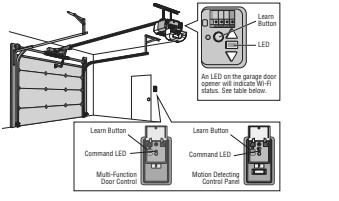
| LED | Definition |
| Blue | Off – Wi-Fi is not turned on. Blinking – Garage door opener is in Wi-Fi learn mode. Solid – Mobile device connected to the garage door opener. |
| Blue and Green | Blinking – Attempting to connect to router. |
| Green | Blinking – Attempting to connect to the Internet server. Solid – Wi-Fi has been set up and garage door opener is connected to the internet. |
NOTES:
The myQ Smartphone Control WILL NOT work if the garage door opener is operating on battery power.
If you need help adding devices to your myQ account, or to learn more go to WiFiHelp.LiftMaster.com.
Using the Multi-Function Door Control
SYNCHRONIZE THE DOOR CONTROL
To synchronize the door control to the garage door opener, press the push bar until the garage door opener activates (it may take up to 3 presses). Test the door control by pressing the push bar, each press of the push bar will activate the garage door opener.
Up to 2 Smart Control Panels® or 4 of any other Security+ 2.0© door controls can be connected to the garage door opener.
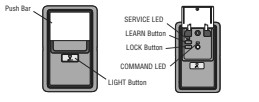
PUSH BAR
Press the push bar to open or close the door.
LIGHT BUTTON
Press the LIGHT button to turn the garage door opener lights on or off. When the lights are turned on they will stay on until the LIGHT button is pressed again, or until the garage door opener is activated. Once the garage door opener is activated the lights will turn off after the specified period of time (the factory setting is 4-1/2 minutes). The LIGHT button will not control the lights when the door is in motion.
The following features are accessible by lifting up the push bar:
LEARN A DEVICE
Any compatible remote controls, wireless keyless entry, Wi-Fi garage door openers, or myQ® accessories can be programmed to the garage door opener by pressing the LEARN button on the door control.
LOCK
The LOCK feature is designed to prevent activation of the garage door opener from remote controls while still allowing activation from the door control and keyless entry. This feature is useful for added peace of mind when the home is empty (i.e. vacation).
AUTOMATIC LIGHT
Light Feature
The lights will turn on when someone enters through the open garage door and the safety reversing sensor infrared beam is broken.
MAINTENANCE ALERT (MAS)
This feature assists the homeowner in ensuring the garage door opener system stays in good working condition. When the garage door opener needs to be serviced (approximately 4500 garage door opener cycles) the command (yellow) and service (red) LEDs will begin to alternately flash back and forth. The factory setting for the MAS feature is off and can be activated at time of installation. Contact your installing dealer for service.
Using the Multi-Function Door Control
LOCK
Your remote controls will NOT work when LOCK mode is active however your keyless entry will still allow access to your garage.

Activate:
Press and hold the LOCK button for 2 seconds. The command LED will flash as long as the lock feature is activated and your handheld remote control will not operate your door at this time.
Deactivate:
Press and hold the LOCK button again for 2 seconds. The command LED will stop flashing and normal operation will resume.
LIGHT
To change the amount of time the garage door opener lights will stay on:
Press and hold the LOCK button until the garage door opener lights flash.* The time interval is indicated by the number of flashes.
| Number of times garage dooropener lights flash | Time the garage door opener light stays on |
| 1 | 1-1/2 Minutes |
| 2 | 2-1/2 Minutes |
| 3 | 3-1/2 Minutes |
| 4 | 4-1/2 Minutes |
To cycle through the time intervals repeat the step above.
* Approximately 10 seconds
LIGHT FEATURE (Default is Active)
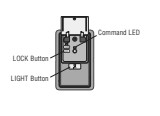
Deactivate:
Press and hold the LIGHT button until the garage door opener lights turn on, then off again.*
Activate:
Start with the garage door opener lights on.
Press and hold the LIGHT button until the garage door opener lights turn off, then on again.*
If the command LED is continuously blinking, the LOCK feature needs to be deactivated.
MAINTENANCE ALERT SYSTEM (MAS):
Activate /Deactivate:
Press and hold the LEARN button. Then press the LIGHT button. The service LED will flash the status; Active is 2 flashes and deactivated is 3 flashes.
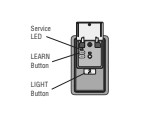
You can download the complete PDF version of the Liftmaster Garage Door opener user manual here.
